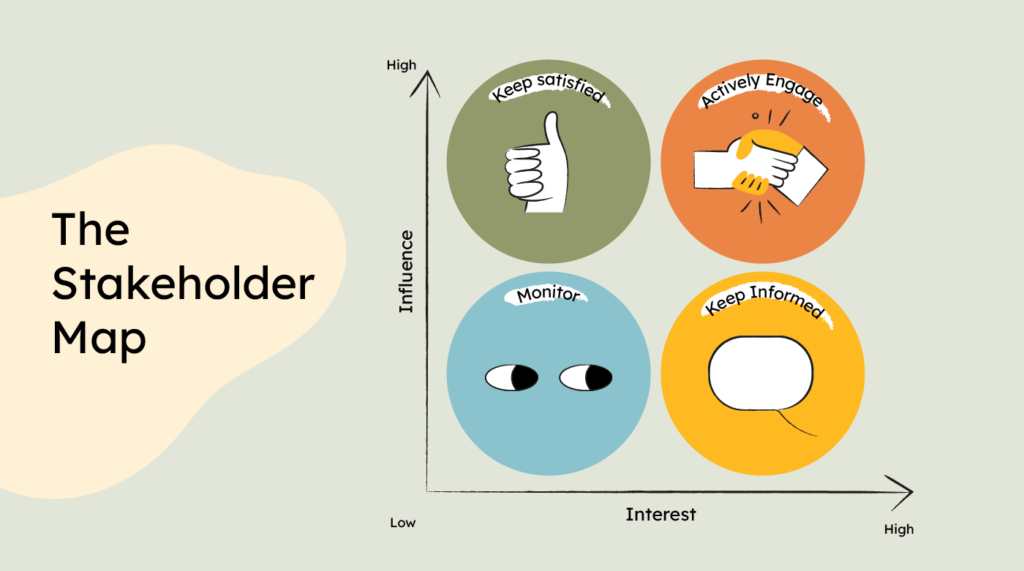One of the most fun, and most challenging, elements in product management is working with a range of interdisciplinary stakeholders.
Every product manager has to deal with stakeholder management. After all, you are building the product in collaboration.
A product manager must communicate with multiple stakeholders on any given day, so the ability to articulate thoughts to various types of stakeholders is essential.
Every stakeholder has a unique way of thinking, and as such, contributes something unique to the product strategy. A designer approaches a product in a very different way than an engineer, while a Vice President would approach it differently than an operations manager. A product manager must master stakeholder management and explain ideas in ways that each stakeholder understands. Before we discuss how to successfully manage and provide value to stakeholders, let’s define a stakeholder, and review the various types of stakeholders you might need to collaborate with.
Who Are Product Stakeholders?
Individuals or groups of people who have a direct or indirect interest in the organization and/or vice versa are referred to as stakeholders. They are individuals, organizations, and institutions with an interest in developing and/or delivering the organization's products and services in some capacity.
A product stakeholder is anyone in the industry who has the ability to influence your product. It’s someone who has passion for the growth of the product, makes decisions, and impacts the product in a direct or indirect way.
The important thing to remember here is that successful stakeholder management requires a lot of communication, which builds trust. Without the trust that you will be able to address their concerns or implement their vision, stakeholders may stop listening to what you have to say and resort to power struggles, potentially preventing your project from being completed on time or successfully.
Stakeholders are much more likely to support your project if they know you understand their concerns, feel they have a voice to contribute to the product vision, and are kept informed about important changes and initiatives.
Internal Product Stakeholders
Internal stakeholders make up half of the 'customers' and 'users' with whom product managers must interact on a regular basis.
They can include a variety of different functions and roles throughout the company, ranging from administrative functions such as marketing, legal, sales, and finance to C-suite executives or department heads, as well as other product managers. Here are some examples of internal stakeholders and a playbook for managing their involvement in the product life cycle.
Executive stakeholders
The executive stakeholders are the board of directors and investors. They are very results-oriented, and you do not want their haste to affect the value of the product you are managing. Therefore, you must find a mutually satisfying way to interact with executives. In my experience, these stakeholders are most concerned with issues such as branding and revenue.
- Communication should be clear and concise
- Be positive and confident
- Brief them on important details and information
Engineering stakeholders
The engineering teams are also stakeholders and should be treated as such. Frequently, they will contact you, as the product manager, to clarify what the product team expects from them. You must understand the product and effectively communicate it to them; it’s essential to explain the strategy to be used as well as to break down their tasks for them.
The engineering team in my first product role was difficult to manage; they always wanted to sideline me because they could see I was drawing a blank on many of the topics they wanted to discuss. I handled the situation by spending hours reading and understanding more about their craft. Trust me, your development team can sense it if you do not understand them, so don’t pretend. I also recommend brainstorming with them to create a better user experience.
Sales stakeholders
The sales team, and I mean this respectfully, is only concerned with how they can sell a product. When explaining the product to sales, you should also explain how they can sell it. When speaking with the sales team, avoid focusing solely on features; instead, learn to think like them by explaining why a feature should and will sell, and try to highlight the product's selling points to them.
Marketing stakeholders
You must exercise caution when working with this particular type of Product Preachers. You put the products on the shelves, and their role is to move them from the shelves to the customers. If you don't tell them what's special about the product, they'll push products from the shelf to the customer without preaching the right gospel to them.
There may be many more internal stakeholders depending on the size and structure of the company; for example, legal and compliance, customer success, et cetera. Make sure to treat each of your internal stakeholders appropriately based on their role, and always maintain open communication with them at all stages.
External Product Stakeholders
External stakeholders are people or factors who operate outside of the business's internal affairs but face risk based on the company's performance. Customers, for example, can be considered key external stakeholders in any business. Because the customer is exposed to risk as a result of the company's performance, they are classified as an external stakeholder.
Here’s a rundown of other common external stakeholders.
Government regulators
Organizations such as the IRS, which enforces tax laws, and worker safety organizations such as OSHA or the EPA are examples of government regulators. The government's job is to protect the rights and safety of consumers and the environment, as well as to ensure proper taxation, and compliance with regulations can affect everyone inside and outside the business.
Customers
As I mentioned above, customers are one of a company's most important external stakeholders. Customers are usually the first to be affected by a company's activities. When a company offers a great product that customers love, it increases customer trust as well as the likelihood that customers will refer the brand to friends and family, increasing sales and brand awareness.
Investors
Any company that is funded by investors, whether that be a single angel investor or thousands of shareholders in a publicly traded company, is accountable to those investors. Investors expect that every effort is being made to ensure that the company, and therefore the products, they’ve invested in will lead to a sizable return.
Who Is Responsible for Managing Product Stakeholders?
(Hint: It's you.)
Product managers, and sometimes product owners, are at the intersection of business goals, user problems/insights, and the solutions and technology being developed to achieve the company’s business goals. Given the context and decision-making power they have, it rests on product managers to align and communicate proactively with their partners and team members about their reasoning and product decisions. It is the responsibility of the product manager to ensure that their partners are aligned on the product roadmap and that partners provide all possible support to solve user problems and make the product development process successful.
Giving the product team and customer support the information and tools to address issues, aligning leadership on important choices, and aligning the product marketing and logistics teams to assist with scaling up a product are all components of partnership and stakeholder management. To make sure that their product has all the support necessary to be successful, product managers must work with all sorts of stakeholders in nearly every department in a firm. Without a doubt, stakeholder management skills are essential for success as a product manager.
As you succeed as a product manager, the significance of stakeholder management keeps increasing. Additionally, the soft-skills side of the job is particularly challenging to structure. However, with a few key components, any PM can excel at stakeholder management:
- A positive relationship with your partners (as well as your users)
- Trust and credibility
- Consistent and proactive communication
- Being a true partner, rather than just a product manager who drives alignment
These are relatively insignificant in any work/life balance relationship. However, there are specific actions that product managers can take to enable effective collaborations and continue to improve stakeholder management.
Prioritizing and Managing Product Stakeholders

With so many different people involved in the product life cycle, it can be challenging to balance the degrees of influence each party should have. This grid will make it easier for you to prioritize your different stakeholders. A VP of the company, for example, will have high interest and power, so you will need to manage him/her closely. Meanwhile, an operations team lead has high interest but low power, so you can merely keep him or her informed. In other words…
- High-level, highly interested individuals (Manage Carefully): You must fully engage these individuals and make every effort to satisfy them.
- High power, less interested people (Keep Satisfied): Do enough work with these people to keep them satisfied, but not so much that they become bored with your message.
- Low power, highly interested people (Keep Informed): Adequately inform and consult with these people to ensure that no major issues arise. People in this category are frequently very helpful with project details.
- Low power, less interested people (Monitor): Keep these people informed with occasional updates but don’t extend yourself by involving them in decision-making processes.
Engaging stakeholders is crucial for every organization since it offers chances to better match corporate practices with social requirements and expectations, which promotes long-term value. Here are a few more tips for managing product stakeholders successfully.
Create a stakeholder management plan
This is a must! You can read our how-to guide on making a stakeholder management plan and get started by downloading our free template.
Communicate appropriately
Every business, team, and stakeholder group is unique. As a result, it is critical that you select the most effective communication channels for consistently getting your message out there. This could be a scheduled meeting, an email, or a Slack update. Each has benefits and drawbacks that need to be taken into account.
Define expectations
Be quite explicit on what the stakeholder expectations are and inquire about the project's success metrics. You will undoubtedly come across various notions of success. Some people will prioritize achieving the ultimate deadline above all else. Another person could believe that the final product's usability for end users is its most crucial component. Make goals crystal clear and plan ahead how to resolve disputes.
Report to your stakeholders
Reports are an excellent tool for outlining the work that was completed over the course of a week or month. Do not forget that reports do not need to be lengthy. Simple emails that list the tasks that were performed for the week are usually all your stakeholders need to see.
Keep it together.
A harmonious approach to stakeholder management, coupled with clear expectations and streamlined communication, are all key to getting your product across the finish line with minimal delays.
You might also find these tools helpful in your product management journey:
Don't forget to subscribe to our newsletter to stay up-to-date with all the latest product management news!


